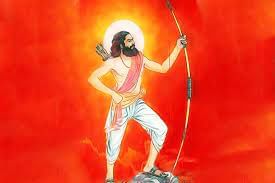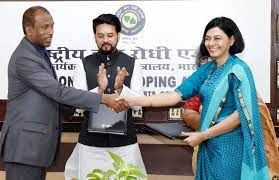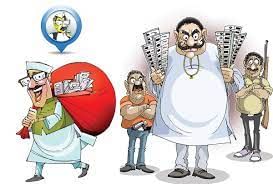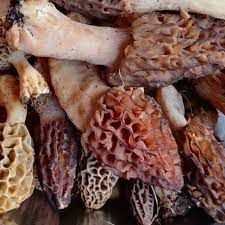UPSC Daily Current Affairs- 4th July 2023 | Current Affairs & Hindu Analysis: Daily, Weekly & Monthly PDF Download
| Table of contents |

|
| GS-I |

|
| GS-II |

|
| About South Asia Regional Anti-Doping Organization (SARADO): |

|
| GS-III |

|
| About Gucchi mushroom: |

|
GS-I
Alluri Sitarama Raju

Why in News?
Recently, President Droupadi Murmu attended the birth anniversary of legendary freedom fighter 125th Alluri Sitarama Raju in Hyderabad.
Background:-
- The 125th birth anniversary of Alluri Sitarama Raju was celebrated in Hyderabad on 4th July 2023.
- A 3D animation on the life of the revolutionary freedom fighter was also launched on the occasion.
About Alluri Sitarama Raju:-
- Born on: July 4, 1897, in Andhra Pradesh.
- He was nicknamed “Manyam Veerudu” (Hero of the Jungle) by local villagers for his heroic exploits.
- He was an Indian revolutionary who waged an armed campaign against British colonial rule in India.
- Sitarama Raju, under the influence of Gandhi’s Non-cooperation movement, inspired the tribals to seek justice in the local panchayat courts and boycott the colonial courts.
- He started to work for the Adivasi of the Eastern Ghats, who were living in abject poverty and being fleeced by police, forest and revenue officials.
- Rampa Rebellion: He launched the Rampa Rebellion against the British in 1922.
The Rampa Rebellion
- Launched: 1922 was a tribal uprising.
- Leader: Alluri Sitarama Raju.
- Location: Godavari Agency of Madras Presidency, British India.
- The Rampa administrative area was home to about 28,000 tribes.
- Cause of rebellion: the passing of the 1882 Madras Forest Act.
- 1882 Madras Forest Act: it restricted the free movement of Adivasis in their forest habitats and prevented them from practising a traditional form of agriculture known as
- Tools: He utilized sporting traditional weaponry like bow-and-arrow and spears and employed tactics like using whistles and beating drums to exchange messages amongst themselves.
- War technique: Guerrilla warfare: His deep understanding of the forest terrain and skilful use of tribal war tactics made him a highly successful guerrilla warrior who struck terror in the hearts of the British.
- Death: In 1924, Raju was taken into police custody, tied to a tree, and shot, effectively ending the armed rebellion.
Legacy and Recognition of Alluri Sitarama Raju:–
- Postal stamp: The Independent Indian Government released a postal stamp in his honour at the village of Mogallu, considered by many to be his birthplace.
- In 2022, the Government of Andhra Pradesh carved out a new district named after Alluri from the erstwhile Visakhapatnam district.
- Bronze statue: Prime Minister Narendra Modi unveiled a 30-foot tall bronze statue of revolutionary fighter Alluri Sitarama Raju at Pedda Amiram village in West Godavari district.
- Every year, the Government of Andhra Pradesh commemorates his birth date, the 4th of July, as a state festival.
Source: AIR
Chenchu tribals

Why in News?
Recently, the Chenchu tribals, joined the drive to make Nallamala forests of Andhra Pradesh free of plastic.
Background:-
- Eco-tourism, nature trails, jungle safaris and wildlife tourism brought the menace of plastic pollution.
- The native Chenchu tribals have been roped in for a drive to become the green warriors of the Nallamala forests of Andhra Pradesh.
About Chenchu tribals:-
- The Chenchu are a tiny migratory forest tribe from
- They migrate over the state lines of Andhra Pradesh and Odisha in search of work.
- They are a Particularly Vulnerable Tribal Group (PVTG).
- PVTG: is a sub-classification of a Scheduled Tribe or section of a Scheduled Tribe that is considered more vulnerable than a regular Scheduled Tribe.
- Language: they talk in the Chenchu language, a member of the Dravidian language family.
- Dravidian languages family: a language family spoken by people, mainly in southern India, northeast Sri Lanka, and south-west Pakistan.
- It includes Tamil, Telugu, Kannada, and Malayalam.
- Distribution: They are forest dwellers whose hamlets or Pentas dot the Nallamala forest range spread across four to five districts in Telangana and Andhra Pradesh states.
- They dwell in little homes with wattle dividers that look like colonies.
- They are magnificent climbers.
- Features: they are low in height, with a long head, clear-cut foreheads, and a level nose.
- Their coloring goes from wheat dark to brown, and they have ebony wavy hair.
- Occupation: Their traditional way of life has been based on hunting and gathering.
- They make leaf cups and leaf plates out of tobacco leaves, tamarind, and mahua flowers and sell them in the local marker.
- They also make use of the mahua flower in making the liquor.
- They are also master bamboo cutters and honey catchers.
Nallamala Forest Area
- They are the largest stretches of undisturbed forest in South India, apart from the Western Ghats.
- Location: It is located in Nallamala Hills, which is a part of the Eastern Ghats.
- It lies south of the Krishna River.
- Nallamala Forest Reserve is located in the Nallamala Ranges of the Eastern Ghats.
- A part of the forest reserve belongs to the Nagarjunsagar-Srisailam Tiger Reserve which is the largest Tiger Reserve in India.
- Climate: It has a warm to hot climate throughout the year.
- Summer is especially hot and winters are mostly cool and dry.
- It gets most of its rain during the South West monsoon.
- Vegetation: Tropical dry deciduous.
- Fauna: tigers, leopards, such as black buck, wild hog, peacock, pangolin, Indian Python King Cobras and several rare bird species.
Source: The Hindu
National Maritime Heritage Complex

Why in News?
Recently, Union Minister of Ports, Shipping and Waterways, reviewed the project process of National Maritime Heritage Complex (NMHC), Lothal in Gandhinagar, Gujarat.
- NMHC complex will have Asia’s Biggest Under Water Marine Museum and India’s Grandest Naval Museum.
What is the National Maritime Heritage Complex?
- About:
- The NMHC is being constructed at the historic Indus Valley civilization region of Lothal, Gujarat, under the Ministry of Ports, Shipping, and Waterways.
- Its primary objective is to showcase the maritime heritage of India from ancient to modern times, utilizing an edutainment approach and incorporating the latest technology.
- Significance:
- The NMHC is set to become the world's largest maritime museum complex and an international tourist destination.
- It will play a crucial role in educating visitors about India's rich maritime history and elevate India's image in the global maritime sector.
- The project is part of the Sagarmala Programme and is being developed with the participation of public and private institutes, organizations, and corporate social responsibility (CSR) initiatives. Major ports in India have also contributed funds to support the project.
- Unique Features of NMHC:
- Includes Lothal Mini Recreation; Four theme parks: Memorial, Maritime and Navy, Climate, and Adventure and Amusement; Coastal States Pavilion.
Source: PIB
GS-II
South Asia Regional Anti-Doping Organization (SARADO)

Why in News?
Recently, the National Anti-Doping Agency, India (NADA India) signed a Memorandum of Understanding (MoU) with South Asia Regional Anti-Doping Organization (SARADO) in New Delhi.
About South Asia Regional Anti-Doping Organization (SARADO):
- It was formed on 16th May 2007 in the South Asian Anti-Doping Program Project Development Meeting held in Maldives.
- Member countries: Bangladesh, Bhutan, Maldives, Nepal and Sri Lanka.
- Mission: To promote and co-ordinate the fight against doping in sport in all its forms in among South Asia RADO member countries.
What are the objectives of the recent MoU?
- The MoU, through the project plan and areas of cooperation, aims to fulfil the following objectives over a period of three years:
- Developing an anti-doping education & prevention program in South Asia;
- Training & upskilling sample collection personnel, educators & other anti-doping education officers;
- Organizing courses, seminars, workshops, research & exchange tours on anti-doping education & prevention;
- Facilitating exchange of education officers, program managers, trainers, teachers and specialists on anti-doping education & prevention.
- Supporting anti-doping education activities and exchanging services of experts.
Key Facts about NADA
- It was established by the Government of India, with the objective of acting as the independent Anti-Doping Organization for India having a vision of dope-free sports.
- It was set up as a registered society under the Societies Registration Act of 1860 on November 2005.
- The primary functions of NADA are as under:
- To implement the Anti-Doping Code to achieve compliance by all sports organizations in the Country.
- To coordinate dope testing program through all participating stakeholders.
- To promote anti-doping research and education to inculcate the value of dope free sports.
- To adopt best practice standards and quality systems to enable effective implementation and continual improvement of the program.
Source: PIB
Criminalisation of politics in India

Why in News?
The Association for Democratic Reforms (ADR) wrote to the Election Commission seeking action against parties that fail to publish details of criminal antecedents of candidates as per orders of the Supreme Court and the poll panel.
About Criminalisation of Politics:
- Criminalization of politics is defined as the situation when criminals participate in the politics of the government, i.e., contest elections and are elected to the Parliament and state legislatures.
- This growing menace has become a big problem for our society, affecting the basic principles of democracy, such as fairness in elections, following the law, and being accountable.
- According to data from the ADR, the number of candidates with criminal charges elected to Parliament in India has been on the rise since 2004.
- In 2004, 24% of parliamentarians had pending criminal cases, which rose to 43% in 2019.
- In a petition filed in Feb 2023, it was claimed that there has been an increase of 44% in the number of MPs with declared criminal cases since 2009.
- In the 2019 Lok Sabha elections, 159 MPs had declared serious criminal cases against them, including those of rape, murder, attempt to murder, kidnapping, crimes against women.
Causes of criminalization of politics
- Muscle power: An ideology that works behind adopting the method of muscle power is that if one party cannot secure faith in society, then fear and violence may aid them in the same.
- When there is a nexus between political parties and criminals, the most dangerous elements in society take birth.
- Money power: Black money and funds from the mafia are also significant causes of criminalization in politics.
- Money accumulated through unlawful acts also acts as one of the primary reasons for increasing criminalization in politics
- Corruption: When contempt of law combines with the criminalization of politics, it gives birth to flourishing corruption.
- Growing corruption ultimately leads to the criminalization of politics.
- Divisions in the Indian political system: The Indian political system is based on divisions in which our Indian society exists.
- Criminals take advantage of this division and enter the arena of politics.
- People tend to vote based on the candidates’ caste, ethnicity, religion, community, and linguistic lineage.
- No retirement policy in Indian politics: There is no retirement policy for Lok Sabha members, and hence some members never retire.
- The issue of family fiefdom seriously jeopardizes the careers of budding politicians and lawyers.
Effects of criminalization of politics:
- Hampering free and fair election: limited choice of voters to elect a candidate to parliament or state.
- It is against the spirit of free and fair election, which is the bedrock of a democracy.
- Unhealthy democratic practice: The major problem is that the law-breakers become lawmakers; this affects the efficacy of the democratic process in delivering good governance.
- These unhealthy tendencies in the democratic system reflect a poor image of the nature of India’s state institutions and the quality of its elected representatives.
- Circulation of black money: It also leads to increased circulation of black money during and after elections, which in turn increases corruption in society and affects the working of public servants.
- Culture of violence: it introduces a culture of violence in society, sets a bad precedent for the youth to follow, and reduces people’s faith in democracy as a system of governance.
- Weakening the institutions: This is a pervasive malaise in our body politic, which is assuming cancerous proportions.
- As a result, the three main pillars of our democracy, namely, Parliament, judiciary and executive, are progressively weakened, and the fundamental concept of a democratic system is subverted.
Measures to Curb Criminalization of Politics:
Section 125A of the Representation of Peoples Act:
- The Act should be amended, in order to provide more stringent punishment for concealing or providing wrong information in Form 26 under the Conduct of Election Rules, 1961 to a minimum term of two years’ imprisonment.
Second Administrative Reforms Commission:
- It recommended amending the Section 8 of Representation of People Act, 1951 for disqualifying persons who are facing charges related to heinous crimes and corruption, if charges are framed 6 months before the election.
- Bringing greater transparency in campaign financing is going to make it less attractive for political parties to involve gangsters.
Supreme Court Landmark Judgements:
- Association for Democratic Reforms v. Union of India (2002): In 2002, the SC ruled that every candidate contesting election has to declare his criminal and financial records along with educational qualifications.
- Lily Thomas v. Union of India (2013): The SC has declared that any member of parliament or state legislative assembly who is convicted of a crime and sentenced to a prison term of two years or more would be disqualified from holding office.
- Public Interest Foundation v. Union of India (2019): The SC has ordered political parties to publish the criminal records of their candidates on their websites, social media handles, and newspapers.
- The court also directed the ECI to create a framework to ensure that the information on candidates’ criminal records was disseminated effectively.
Way Forward:
The criminalization of politics and corruption hits the roots of democracy. There should be wide publicity of the candidates with criminal records, who are contesting in an election and the political parties that give them support.
There is a need to bring greater transparency in the campaign financing of political parties. The political parties must be brought under the Right to Information Act to improve their transparency and accountability. The Parliament should enact a law dealing with increased criminalization of politics. Further, of courts dealing with sitting legislators would be crucial for the decriminalization of politics.
Source: Indian Express
GS-III
Gucchi mushroom

Why in News?
Unpredictable weather patterns, early springs, and above-average temperatures have left gucchi mushroom hunters in distress.
About Gucchi mushroom:
- It is a species of fungus in the family Morchellaceae of the Ascomycota.
- It is also known as morel.
- They are pale yellow in colour with large pits and ridges on the surface of the cap, raised on a large white stem.
- Ideal weather conditions for the great morel are daytime temperature is between 15 and 20 Celsius and night-time temperatures are in the five to nine.
- It cannot be cultivated commercially and grow in conifer forests across temperature regions, and the foothills in Himachal Pradesh, Uttaranchal, and Jammu and Kashmir.
- These mushrooms usually grow in clusters on logs of decaying wood, leaves or humus soil.
- They may or may not grow in the same spot the next season, which only makes the process of collection more tedious.
- It is known to be one of the most expensive mushrooms.
What are the health benefits?
- They are rich in potassium, vitamins and copper.
- They are also a rich source of vitamin D apart from several B-vitamins.
- It is further rich in antioxidants that prevent health issues including heart diseases and diabetes by removing reactive oxygen species that harm the body.
Source: DTE
India Joins Artemis Accords

Why in News?
Recently, India's Prime Minister announced India's decision to join the Artemis Accords during the visit to the United States.
- National Aeronautics and Space Administration (NASA) and Indian Space Research Organisation (ISRO) will collaborate to send Indian astronauts, trained at the Johnson Space Center in Houston, Texas, to the International Space Station (ISS) in 2024.
- About:
- Artemis Accords are established by the U.S. State Department and NASA with seven other founding members: Australia, Canada, Italy, Japan, Luxembourg, the United Arab Emirates, and the United Kingdom in 2020 for setting common principles to govern civil exploration and use of outer space, the moon, Mars, comets, and asteroids, for peaceful purposes.
- It builds upon the foundation of the Outer Space Treaty of 1967.
- The Outer Space Treaty, a multilateral pact under the United Nations, serves as the foundation for international space law.
- The treaty emphasizes space as a shared resource for humanity, prohibits national appropriation, and encourages the peaceful use of space.
- Commitments under the Accords
- Peaceful Purposes: The signatories will implement memorandum of understanding (MOUs) between governments or agencies to conduct space activities for peaceful purposes in accordance with international law.
- Common Infrastructure: Signatories recognize the importance of common exploration infrastructure to enhance scientific discovery and commercial utilization.
- Registration and Data Sharing: Relevant space objects are registered, and scientific data is openly shared in a timely manner. Private sectors are exempt unless acting on behalf of a signatory.
- Preservation of Heritage: Signatories are expected to preserve historic landing sites, artifacts, and evidence of activity on celestial bodies.
- Utilization of Space Resources: Utilization of space resources should support safe and sustainable activities and not interfere with other signatories' activities. Information on location and nature must be shared to prevent interference.
- Mitigation of Debris: Signatories plan for the safe disposal of spacecraft and limit the generation of harmful debris.
What are the Main Missions under the Artemis Program?
- Artemis-I: Unmanned Mission to the Moon
- The Artemis program began with the launch of the spacecraft named "Orion" on the Space Launch System (SLS) from NASA's Kennedy Space Center on November 16, 2022.
- The SLS, a super heavy-lift launch vehicle, carried Orion on a single mission directly to the moon.
- Artemis-II: Crewed Lunar Flyby Mission:
- Scheduled for 2024, Artemis-II will mark the first crewed mission under the Artemis program.
- Four astronauts will be aboard the SLS as it performs multiple maneuvers on an expanding orbit around Earth.
- The mission will also involve a lunar flyby and return to Earth.
- Artemis-III: Human Return to the Moon:
- Set for 2025, Artemis-III will mark a significant milestone in human space exploration as astronauts return to the moon.
- This mission will go beyond the lunar flyby of Artemis-II, allowing astronauts to land on the lunar surface and study the moon more extensively.
- Also, the establishment of a Lunar Gateway station is planned for 2029. This station will serve as a docking point for astronauts and facilitate scientific research and experiments.
- Benefits:
- India's participation in the Artemis Accords facilitates access to advanced training, technological advancements, and scientific opportunities.
- India can leverage the Artemis programme to advance its own lunar exploration goals, such as the Chandrayaan-3 mission.
- Collaborating with NASA would enhance India's capabilities for the Gaganyaan human mission and future ambitious space missions.
- Also, India's cost-effective missions and innovative approach will benefit the Artemis program, promoting mutual advancements in space exploration.
- Challenges:
- The possibility of being seen as aligning with the U.S. against other major space powers, such as China and Russia, who have their own plans for lunar exploration.
- The uncertainty over the legal status and implications of the Artemis Accords, especially regarding the provision that allows for unregulated mining on the moon and other celestial bodies.
- The need to balance its commitments under the Artemis Accords with its obligations under other existing or emerging multilateral frameworks or treaties on outer space.
Source: The Hindu
|
38 videos|5293 docs|1118 tests
|















